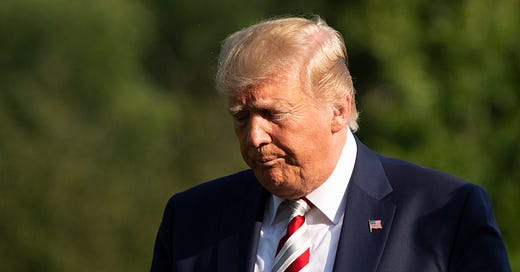
New Polls Show That Trump Should Be Afraid. Very Very Afraid.
It's not that his approval rating is low (although it is). It's that his disapproval rating is so high.
Political pundits ought to hold themselves to the standard of revisiting their predictions and with a coldly objective eye. Having made two rather bold projections in these pages recently, it’s my turn to do so.
In July I argued that Donald Trump’s strategy of race baiting against the so-called “Squad” of four minority female members of Congress would not go well for him. I wrote that “I wouldn’t assume that we may not look back and see this as being the Ides Of August for Trump.”
Two weeks later I asked, “Could This Be the Moment Trump loses America?” I argued that a triad of events—Trump’s attack on the Squad, tied to the rhetoric of “send them back” with the backdrop of his repeated referencing of “invasion,” which then rolled into the tragic massacre in El Paso, on the same weekend as Dayton also suffered a mass shooting—brought the peril of a sharp and decisive public rebuke of Trump and his presidency. “If these voters, the vital center of the American electorate, come to believe that Donald Trump as president, his rhetoric and political style, have become a threat to public safety, that is a seminal development,” I wrote.
Many of my Republican friends weren’t sure if I was right or wrong, while my Democratic friends feared that I was wrong, but literally were praying that I was right. I responded to both with same refrain: it does not matter what I think or you think, the key is how do the American people react. I doubted that “the public will have a neutral or modest reaction if this perception of licensing hate hardens.”
The problem was that the polling data, an intrinsically lagging indicator, was having trouble registering a true reading of public opinion since events were moving so fast. But the data is starting to roll in now and as G. Elliott Morris, who covers polling for the Economist, pointed out in a tweet over the weekend, that the “high quality pollsters” like Gallup, Pew, and Fox News all contained bad news for Trump and his presidency.
The Fox News polls were released on August 14 and 15, from a sample of 1,013 registered voters taken from August 1-14. The large sample in this Fox poll had a margin of error of only plus or minus 3 percent. The big takeaway is the increase in the president’s disapproval rating. If this poll is accurate, then Trump could indeed be losing America.
The least significant data point in the Fox News poll was that Trump’s job approval declined from 46 percent in July to 43 percent in August. Instead let’s focus on his disapproval rating. Not only was it up 5 percentage points to 56 percent (only one point below the highest disapproval rating of his presidency in October of 2017), but it’s up above 50 percent for almost every demographic: 64 percent among independents, 53 percent among men, 46 percent among white men, 53 percent of those older than 45, 61 percent among suburban women (59 percent of women overall), and 55 percent among whites with a college degree. Trump’s disapproval ratings even inched up to 11 percent among Republicans (only 7 percent of Democrats approve of Trump’s job performance) and a full 26 percent among self- described conservatives (only 11 percent of liberals approve of Trump’s job performance). He has a whopping 71 percent of moderate voters disapproving as well. In short, Trump’s approval-to-disapproval ratio got worse among those he needs to have any chance of winning: older white, suburban, moderately to conservative and Independent voters.
The NBC/WSJ, Gallup, and Pew data back up the Fox News results. The NBC News/WSJ poll had a slight decline in Trump’s job approval in their poll released on August 19, with Trump at 43 percent compared with 45 percent registered in a July 19 poll that came out just before the “send them back” canard took hold. And the NBC/WSJ poll showed Trump’s disapproval rating up to 55 percent from 52 percent. Gallup put Trump’s job approval to disapproval at 41 percent to 54 percent in their August 1-14 survey, compared with a 44 percent approval/ 51 percent disapproval on a July 1-12 survey on that same scale (before Trump launched the “send them back” triad of divisiveness). And Pew put Trump’s job approval at 40 percent but his disapproval at 59 percent (in a survey of 4,175 taken from July 22 through August 4, with a margin of error of only 1.9 percent).
In terms of the events driving this decline in Trump’s public prestige, other results were even more telling than Trump’s job approval ratings. Only 37 percent of voters told Fox News that they supported Trump’s handling of the shootings in El Paso and Dayton, and 46 percent felt that Trump had made the country less safe. The NBC/WSJ poll put the approval for Trump’s handling of the aftermath of the El Paso and Dayton shootings at 36 percent.
Even worse for Trump was that 56 percent of voters told the Fox News pollster that they felt that Trump had either a great deal or some blame for the mass shootings plaguing America in the last few years (including 34 percent who attributed “a great deal of blame” to Trump). And among those who assigned a “great deal of blame” to Trump were: 40 percent of women, 39 percent of suburban women and 59 percent of black voters (51 percent of all non-white voters). When a third of the nation is blaming their president for such violence, , that erodes the currency of the pledge in Trump’s inaugural address—"This American carnage stops right here and stops right now,"—even if that pledge was predicated on an inaccurate reading of violent crime statistics.
And so it is little wonder that Trump lost the head-to-head matchups against Biden, Sanders, Warren and Harris in the Fox News poll. Worst of all for Trump, he didn’t even reach 39 percent in any head to head matchups. In effect, Trump was running below his job approval levels. That is the political equivalent of (dare we say it?) an inverted yield curve in the bond markets. Why is that important? In their 2004 and 2012 re-election campaigns Bush was running at 47-to-48 percent job approval ratings and got 50 percent of the vote, while Obama was getting 47-to-49 percent job approval ratings and received 51 percent of the popular vote. Both incumbents ran slightly better among swing voters than their opponents.
The best example of this in the Fox data was measured by the fact that among those who rated both Biden and Trump unfavorably, Biden beat Trump by 43 percent to 10 percent. This reversed what Trump achieved in 2016, when as the Washington Post reminded us, Trump won the votes of those who rated both himself and Hillary Clinton unfavorably by 17 percent. An incumbent president running under already anemic job approval ratings is in a serious reelection crisis. In 2016, Hillary Clinton was the de facto incumbent and the public’s doubts and displeasure cut sharply against her; in 2020 that negativity redounds against Trump.
Nor is this phenomenon of Trump running below his job approval numbers in head to head matchups a one- time thing. Back in July, when the NBC/WSJ poll had him at 45 percent approval, Trump was not cracking 42 percent in the head-to-head matchups against Democrats. Serious political handicappers should keep a close eye on whether this “inverted yield curve” takes hold and drags down Trump’s re-election prospects.
In addition, pundits should stop making the mistake that Trump can carry the Electoral College while securing under 42 percent of the popular vote, instead focusing far greater attention on the fact that Trump has a hardening majority of the American electorate opposing his re-election. In fact pundits—as well as the president himself—misunderstand how he pulled off the upset in 2016.
The truth is that Trump’s base did not elect him. His base brought him close, but what paved the road for the inside straight that secured his majority in the Electoral College, was a late swing away from Hillary among suburban women, middle-aged Hispanic men, those with some college but not a four year degree, and independents, combined with a drop in the black turnout. Trump is weaker today than he was in November 2016 in each of those demographic subsets, and the economic uncertainty and distress in the bond markets are affecting the investment accounts of those older voters Trump needs to have any chance of mounting a comeback.
If you doubt the accuracy of that observation go to the cross tabs of the most recent Pew data and track Trump’s disapproval ratings (48 percent among whites, 55 percent among men, 79 percent among Hispanics, 58 percent among Catholics, 55 percent of those with some college but not a four year degree as well as 55 percent of those with a high school degree or less, 55 percent among seniors and 17 percent disapproval among Republicans and Republican leaning Independents). If those levels of opposition hold in terms of Trump’s job approval ratings and he continues to run underneath those levels in terms of securing support from voters for his re-election, Trump will lose unless the Democrats fail to nurture and corral this majority of opposition to Trump’s presidency. Trump has time to change course and the Democrats are capable of imploding, but Donald Trump has shown precious little capacity for change.
If Trump stays on his present course, he will lose next November, and political historians will more than likely come to see the watershed moment as August 2019. And so, Rick Wilson is correct: Trump can’t win, he will be re-elected only if the Democrats blow it. In the final analysis, Trump is on the verge of losing the country, even if the Democrats have not yet found the discipline needed to secure a victory in 2020.










